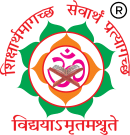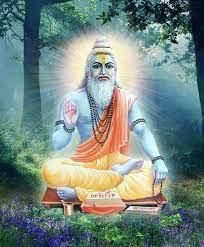Amongst all the rishis, the name of Sri Veda Vyasa stands out prominently. It seems Vyasa lived 3,800 years ago but excavations at Hastinapur show that he was born after the Vedic age about 950 BC. He was the son of the rishi Parsara, the grandson of the great rishi Vasishta.
Vyasa’s Birth and initial life
Vyasa was the son of Satyavati, the daughter of a fisherman and Parasara who was a wandering rishi. Satyavati used to row boats for passengers from one end of the shore to another. Vyasa’s father, Parasara came to know that a child, conceived at a particular moment of time, would be born as the greatest man of the age as a part of Lord Vishnu himself. On that eventful day, Parasara was traveling in a boat and he spoke to the boatman about the nearing of that auspicious time. The boatman had a daughter who was awaiting marriage. That was where Parasara and Satyavati met. Since Satyavati was the daughter of a fisherman, she smelled of fish. Hence Parasara gave her a boon that she would never smell like she had been around fishes ever again. She then gave birth to Krishna dvaipanyana on the shore of River Yamuna. His birth is said to be due to the wish of Lord Shiva, who blessed the birth, the sage of the highest order. He was married to the daughter of rishi Jabali named Vachika. After marriage, he entered the stage of Grihastashrama and then fathered a son named Suka. At a very tender age, Vyasa revealed to his parents the purpose of his life — that he should go to the forest and practice ‘Akhanda Tapas’ or continuous penance. At first, his mother Satyavati did not agree but later approved on one important condition that he should appear before her whenever she wished for his presence. According to the Puranas, Vyasa took initiation from his guru rishi Vasudeva.
Vyasa’s Works
According to Vyasa, the Veda was not stabilized, since there was only one Veda, they weren’t separate at the time. It was hard for people to understand it due to which not many people would be able to read them. To revive the Vedas, he decided to divide the Vedas into four sections. The Vedas were divided in such a way that all the hymns were grouped based on their requirements in the sacrificial rites. Vyasa taught these four Vedas to his four disciples. Rig veda was given to Paila rishi, Atharva veda was given to Sumantu rishi, Sama veda was given to Jaimini rishi and Yajur veda was given to vaisampayana rishi. These rishis, in turn, taught their part of the Vedas to their disciples who then passed down the knowledge to the society. He also wrote the Mahabharata to enable common people to understand the highest knowledge in the easiest way. Vyasa wrote the 18 Puranas and established the system of teaching them through upakhyana or discourses. In this way, he established the three paths of Karma, upasana (devotion) and jnana (knowledge). Vyasa’s last work was the Bhagavatam which he undertook at the instigation of Devarishi Narada, who once came to him and advised him to write it, without which, his goal in life would not be reached. The Brahma Sutras, also known as the Vedanta Sutras is believed to have been written by Vyasa along with Badarayana. They are divided into four chapters, each chapter being subdivided again into four sections. Sankaracharya refers to Vyasa as the author of the Gita and the Mahabharata, and to Badarayana as the author of the Brahma Sutras, while Ramanuja and others attribute the authorship of all three to Vyasa himself.
Vyasa Purnima
Vyasa Purnima is an important day in the Hindu calendar. On this auspicious day, Vyasa began to write his Brahma Sutras. This day is also known as Guru Purnima when Hindus should worship Vyasa and the Brahmavidya Gurus and begin the study of the Brahma Sutras and other ancient books on wisdom.

